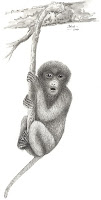
Pagai Pig-tailed Snub-nosed Monkey or Simakobu
Simias concolor Miller, 1903
Indonesia (2002, 2004)
The genus Simias is known only from Indonesia’s Mentawai Islands, a small archipelago situated
off the west coast of central Sumatra. Until humans arrived approximately two millennia ago, its
only predators were probably large constricting snakes and birds of prey. Today, however,
hunting and forest conversion are two substantial threats to the four indigenous Mentawai
primates, all of which are endemic to these islands. Simias concolor was originally considered
monotypic, but is now believed to include two subspecies, S. c. concolor from the Pagai islands
and Sipora, and S. c. siberu Chasen and Kloss, 1927 from the island of Siberut. The common
English name of this large monkey is derived from its short pig-like tail and its shortened nose,
which very much resembles that of the Tonkin snub-nosed monkey (Rhinopithecus avunculus) of
Vietnam, another Critically Endangered species. S. concolor lives in relatively small social
groups with usually one male and one or more females and offspring. Simias concolor occurs in
the few small remaining forest patches on the islands of North and South Pagai and Sipora, and in
the large National Park on Siberut. It may still occur in a few forest patches on small islets off
southern South Pagai Island. However, of the four Mentawai primates, Simias is the most
sensitive to deforestation, having significantly lower densities in logged forests than in unlogged.
Thus, while Simias still survives in spite of human encroachment, hunting, and habitat
disturbance, the vast majority of its remaining natural habitat lies outside of officially protected
areas. These areas are in logging concessions and could very well be lost in the near future.
Lisa Paciulli, Agustin Fuentes & William R. Konstant
Cited from: Primates in Peril, the World’s 25 Most Endangered Primates 2004–2006, (Mittermeier, et.al , 2005)
Ilustration:
1. Interactive CD “Primata Indonesia” published by CI Indonesia,2003



Komentar